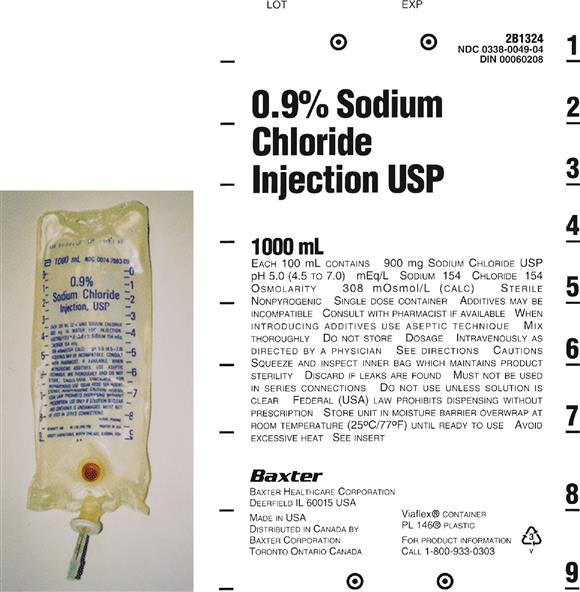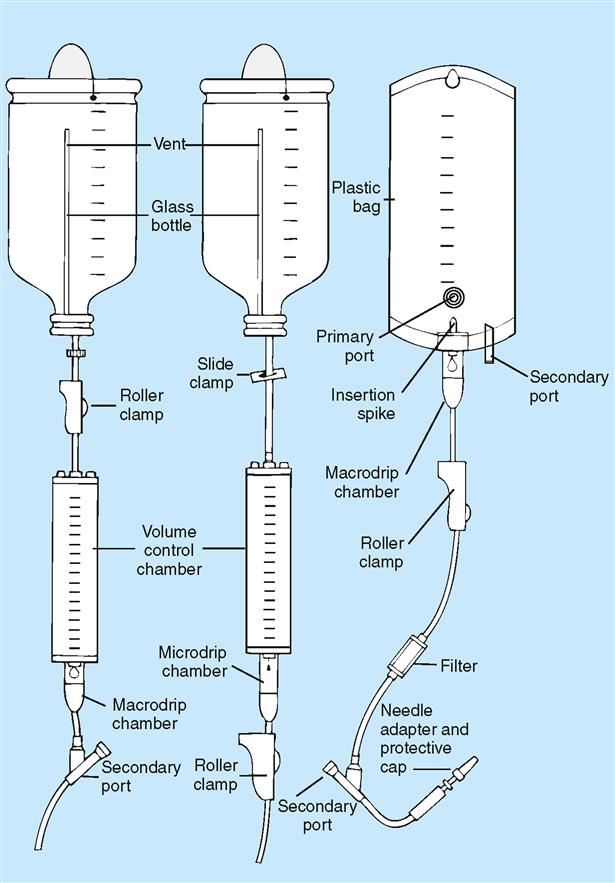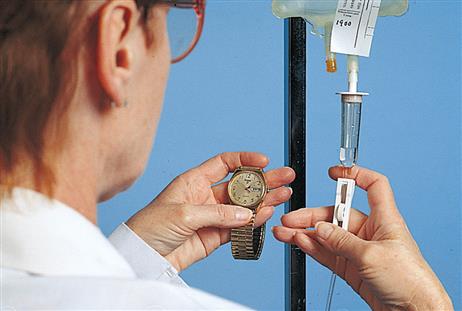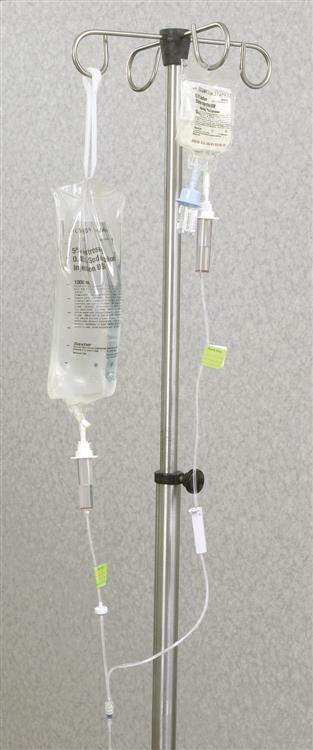 Intravenous Flow Rates
Intravenous Flow Rates
LEARNING OBJECTIVES
On completion of the materials provided in this chapter, you will be able to perform computations accurately by mastering the following mathematical concepts:
![]() It is sometimes necessary to deliver fluids and medications to a patient intravenously. Intravenous (IV) solutions and medications are placed directly into a vein. Infusions are injections of moderate to large quantities of fluids and nutrients into the patient’s venous system. An IV medication or infusion may be prepared and administered by a physician, nurse, or technician as regulated by state law and the policies of the particular health care agency. Medications and electrolyte milliequivalents are commonly ordered as additives to IV fluids. Medications may also be diluted and given in conjunction with IV solutions.
It is sometimes necessary to deliver fluids and medications to a patient intravenously. Intravenous (IV) solutions and medications are placed directly into a vein. Infusions are injections of moderate to large quantities of fluids and nutrients into the patient’s venous system. An IV medication or infusion may be prepared and administered by a physician, nurse, or technician as regulated by state law and the policies of the particular health care agency. Medications and electrolyte milliequivalents are commonly ordered as additives to IV fluids. Medications may also be diluted and given in conjunction with IV solutions.
Intravenous fluids are available in a variety of volumes and solutions. Figures 16-1 and 16-2 show examples of two commonly used IV fluids: 5% dextrose and normal saline, respectively. These examples show 1000-mL IV bags, but IV fluids are also available in 50-mL, 100-mL, 250-mL, and 500-mL bags.
IV fluids are administered via an IV infusion set. This set includes two parts: the sealed bottle or bag containing the fluids and the tubing. The tubing is made up of the following parts: a drip chamber connected to the bottle or bag by a small tube or spike, and tubing that leads from the drip chamber down to and connecting with the needle or catheter at the site of insertion into the patient (Figure 16-3). The flow rate is adjusted to the desired drops per minute by a clamp placed around the tubing or by an IV pump or electronic device. The nurse must be knowledgeable about the equipment being used and, in particular, about the flow rate, or drops per milliliter, that a particular set of tubing will deliver.
Infusion sets come in a variety of sizes. The larger the diameter of the tubing where it enters the drip chamber, the bigger the drop will be. The drop factor of an infusion set is the number of drops contained in 1 mL. This equivalent may vary with different manufacturers. The most common drop factors are 10, 15, 20, and 60 drops/mL. Sets that deliver 10, 15, or 20 drops/mL are called macrodrip sets. A set that delivers 60 drops/mL is called a microdrip set. Macrodrip sets are larger than microdrip sets.
If large volumes of fluid must be administered (125 mL/h or more), a macrodrip set is required. Microdrip sets are unable to deliver large volumes per hour because their drop size is so small. When an IV solution is to run at a rate of 50 mL/h or less, a microdrip set should be used. Some hospitals may even require a microdrip set for rates of 60 to 80 mL/h, for accuracy of flow rate and to help maintain the patency of the line. The number of drops per milliliter for the IV administration set is written on the outside of the box. This information is essential for solving problems related to the regulation of IV flow rates (Figure 16-4).
The physician is responsible for writing the order for the type and amount of IV or hyperalimentation fluids. The number of hours the IV fluid will run or rate of infusion is also ordered by the physician.
Examples of Physician’s Orders for IV fluids:
| 10/20/2015 1300 | Infuse 500 mL of 0.9% NS over 2 hours |
| 10/20/2015 1600 | Infuse D5W 1/2 NS with 20 mEq of KCL at 125 mL/h continuous |
It is usually the nurse’s responsibility to regulate and maintain the infusion flow rate. It is the nurse’s goal to ensure that the IV flow is regular. If the rate is irregular, too much or too little fluid may be infused. This may lead to complications such as fluid overload, dehydration, or medication overdose. Sometimes the flow rate must be adjusted because of interruptions caused by needle placement, condition of the vein, or infiltration.
The nurse must be able to determine the number of drops per minute (gtt/min) the patient must receive for the infusion to be completed within the specified time.
When the volume, time, or length of the infusion, and the constant drop factor are known, a simple formula can be used:

IV Administration of Fluids by Gravity
EXAMPLE 1: Hespan 500 mL is ordered to be infused over 3 hours. The drop factor is 15 gtt/mL. How many drops per minute should be given to infuse the total amount of Hespan over 3 hours?

a. Convert total hours to minutes.
1 h : 60 min :: 3 h : x min
x = 180
Therefore 3 hours equals 180 minutes.
This calculation depends on the drop factor of the tubing being used. Remember, this information is found on the package. For the problems in this work text, the drop factor is indicated. The drop factor for this problem is 15.



Therefore the nurse will regulate the IV to drip at 42 drops/min, and the 500 mL of Hespan will be infused over 3 hours (Figure 16-5). Since the nurse cannot count a fraction of a drop, drops per minute are always rounded to a whole number.
EXAMPLE 2: 1000 mL of dextrose 5% in water (D5W) is ordered to be infused over 5 hours. The drop factor is 10 gtt/mL. How many drops per minute should be given to infuse the 1000 mL over 5 hours?





The nurse will regulate the IV to drip at a rate of 33 gtt/min, and the 1000 mL of D5W will be infused over 5 hours.
Infusion of IV Piggybacks by Gravity
Sometimes the physician will order medications to be administered in a small amount of IV fluid. This medication will need to be infused in addition to the regular IV fluids; it is called an IV piggyback (IVPB) because it is attached to the main IV tubing with shorter tubing of its own (Figure 16-6). The medication for the IVPB may be received premixed by the pharmacy or may need to be prepared by the nurse. The time frame for the IVPB infusion is usually 60 minutes or less.
If the physician does not include an infusion time or rate, it is the nurse’s responsibility to follow the manufacturer’s guidelines. The hospital pharmacy and drug books such as the Hospital Formulary and A Handbook for Intravenous Medication published by Mosby are known resources for fluid rates. The nurse should always refer to recommended fluid limits and rates before IVPB administration.
When the volume, time of infusion, and tubing drop factor are known, the same formula that was used for IV Administration of Fluids by Gravity is used to calculate the flow rate for the IVPB.
EXAMPLE 1: The physician orders cefuroxime 1 g in 50 mL of normal saline solution (NS) to be infused over 30 minutes. The tubing drop factor is 60 gtt/mL. How many drops per minute should be given to infuse the total amount of cefuroxime over 30 minutes?

Calculate gtt/min.



Therefore the nurse will regulate the IVPB to drip at 100 gtt/min, and the cefuroxime will be infused over 30 minutes.
EXAMPLE 2: The physician orders gentamicin 80 mg in 100 mL D5W to be infused over 1 hour. The tubing drop factor is 60 gtt/mL. How many drops per minute should be given to infuse the gentamicin over 1 hour?
a. Convert the total hours to minutes.
1 h : 60 min

Stay updated, free articles. Join our Telegram channel

Full access? Get Clinical Tree








